Mobile Device
-
- Labor Shortages, Climate Change & Technology: They’re All Related Marine News, Aug 2023 #18
Many problems in our “New World” can be solved more quickly than ever due to the speed at which information now travels. Gone are the countless long days of research, because often our questions can be answered instantaneously at a computer terminal or on a handheld mobile device. Traditional investment, research, science and industry have all attempted to reconfigure their business practices to accept that information speed. Unfortunately, government regulation and bureaucracy have not, and as a result, we continue to allow certain problems of the “New World” to be pushed down the road before long-term decisions are made.
With those delays, the labor markets across many, if not all, markets have changed. “Help wanted” signs hang in every storefront, office building and government agency. In no uncertain terms, the maritime industry has been dealing with labor problems, and none of this is news to our industry. The mariner shortage has been discussed at length for years, and it is becoming increasingly difficult to crew not only U.S. flag commercial vessels, but foreign registered ships as well. The labor shortage does not only affect crew labor; it has affected the labor required to fulfill our shipyard production, service and repair companies, agencies and shoreside office staff.
We have discussed how to solve climate change for the past 30 years. IMO has waffled on standards for emission and carbon reduction that will look at another 30 years to 2050. We can all agree that the crew labor shortages have been discussed for over 10 years, if not more. The relationship with all of these issues is time and the generational effect of problem solving. Our youth expect problems to be solved immediately, just as quickly and easily as they receive their information, selfies and text messages. In my opinion, it’s time to put them to work and ask them to help the aging generation reform our traditional practices.
The influence of Gens X, Y and Z has raised many discussions of diversity, inclusion, workplace practices and the cost of higher education. The journey from high school to higher education to realize successful careers for many Black and Latino students along with those from all low-income backgrounds is often anything but successful. If we are looking for growth in the maritime industry, we need to start at the high school level or face losing the skillsets we require to succeed. There is an abundance of solid career opportunities that may require training and certifications but do not require a trip to any university.
The diversity issue is not new to shipping. We have historically looked to underdeveloped and third world nations to provide our deckhands, oilers, welders and unlicensed positions. Many rose through the hawsepipe to achieve officer status and management positions ashore without degrees or higher education. The science and technological changes we are facing with energy, emissions and climate change will demand a new level of training, certifications and maintenance demands for all of these skill sets. The International Chamber of Shipping (ICS) claims we are short 90,000 seafarers worldwide. Our current Administration claims it will create tens of thousands of new jobs tied to U.S. offshore wind alone. How do we fill those positions?
Within our domestic shipping, coastal and offshore industries, the issue now extends beyond the repeated claim of national security. We now seek industrial security.
Education in the United States is also changing, and if you take an interest as a business owner you will hear the word “pathways” in many of the discussions. New England high schools have long recognized the value of developing pathways that meet the needs and interests of their students and surrounding industries. My company Alternative Marine Technologies (Amtech) has taken an interest in assisting the Brian McMahon High School Marine Science Academy in Norwalk, Conn. to learn how marine pathways can solve the problem. Shipping and shipbuilding have history in New England. History needs to repeat itself.
The Marine Science Pathway at Brien McMahon High School is a field-based, four-year program offering students a hands-on experience in all aspects of marine science. The initial program is locally centric in Norwalk, Conn., where there is a large recreational boating community and a marine biology influence from The Maritime Aquarium and local oyster farming. Areas of science, aquaculture and mechanics can present career opportunities within the students’ hometown. We need to pique an interest beyond that local opportunity.
Various technologies, college, career opportunities and experiences through internships and apprenticeships are included in the program. Amtech has worked with two interns to date, one who continued his path through the Navy nuclear program, and another as she entered Annapolis. We believe the pathway needs to expand into commercial shipping careers at sea, supporting not only the surrounding maritime academies, but also careers that do not require higher education to go directly to work. As a result, we are reaching out to industry to help us support the high school programs, grow the programs and provide sponsorship support.
We met with Eva Bartush, Marine Science Academy Coordinator and Stephanie Tom, IBCP, or International Baccalaureate Career Pathway Coordinator, to discuss their “miniboats” program. On May 31, 2022, the students built and launched a solar powered “drifter” hull to track a voyage across the Atlantic Ocean. Students in the program designed and built the boat, and then tracked it by satellite. The project allowed them to learn about ocean currents, weather, hull integrity and GPS technology. The first drifter launched off the U.S. East Coast completed an autonomous voyage and was eventually safely collected by a second group of students in Norway. The Norwegian students continued the voyage into the Norwegian Fiords and farther North.
What was our initial take on the project? This group of students not only completed a successful autonomous voyage but also met the IMO MEPC zero emissions goals during that voyage. They get it, and they are not waiting 30 years to make changes to their world.
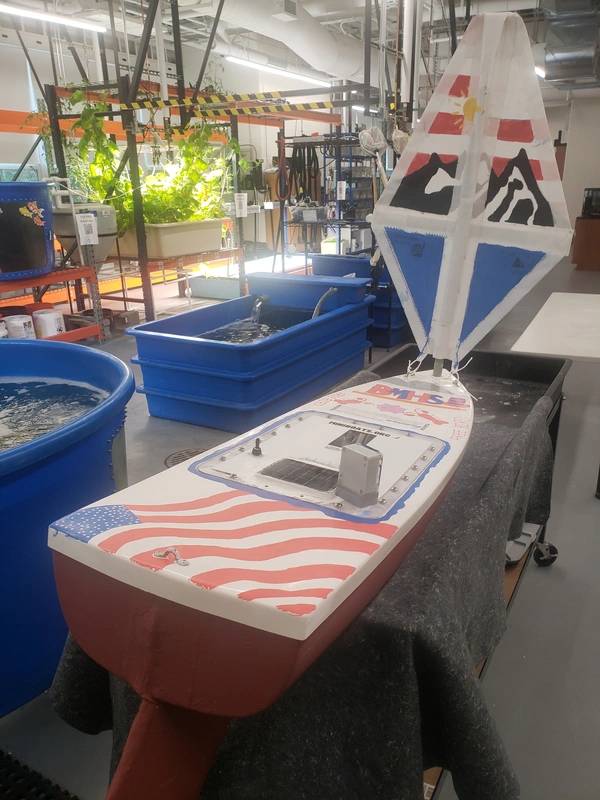 Brien McMahon High School students recently sent a “drifter” on a voyage from the U.S. to Norway. (Photo: Robert Kunkel)
Brien McMahon High School students recently sent a “drifter” on a voyage from the U.S. to Norway. (Photo: Robert Kunkel)We have no less than four maritime academies located in the Tri-State/New England area stretching from New York to Maine. The U.S. East Coast is also the launching point for developing the country’s offshore wind industry. More importantly, the federal government just invested nearly $2 billion in the construction of five NSMV training ships in Philadelphia. The program to replace aging academy training vessels has been a discussion for as many years as we have discussed global warming. The U.S. Maritime Administration (MARAD) needs to develop a more inclusive program using these assets outside of the sea time for academy license requirements. The platforms should be made available to train returning veterans, high school marine science programs and union school applicants to help solve the labor shortage and provide clear pathways to seagoing careers. A path that includes master to able-bodied seaman, crew transfer vessel (CTV) deckhand to wind farm maintenance technician and QMED to chief engineer.
Rotate the NSMVs through our U.S. ports, position them offshore to attend and observe offshore wind farm construction and use them to conduct near coastal ocean research and aquaculture. These ships can be our first effort to create change and market our industry to next generations—generations that will use alternative fuels to help solve climate change and understand the importance of the world’s oceans and the marine industries that need their involvement.
Pick up your mobile device and work toward piquing their interest quickly before these generations decide their future only includes a trip to the moon and Mars.
-
- Tech File: NS Workboat Marine News, Jul 2017 #52
& Play No software is required onboard the vessel. Because the program is based on the daily activities of the crew and offered on a familiar mobile device, only training is required. Great Lakes Dredge & Dock (GLDD), Bering Marine Corp and Genesis Energy are among the first subscribers. Operational
-
- Marine Manufacturers find ... "There’s an APP for that" Marine News, Dec 2013 #48
of Harrington’s market leading products including images, descriptions, individual product specifications and dimensions, and outline drawings on your mobile device. There are also links to Harrington’s full web site, social media and contact information in the application. Users of Harrington Mobile can now
-
- FMT Embraces Electronic Records Management Marine News, Dec 2014 #41
and cabinets full of paper. We were killing trees by the thousands,” he says. “Now we have all the forms electronically, weather on computer or mobile device. They are all right there. No more printing them out and carrying them around.” That’s why Carlton wants the system installed companywide as soon
-
- Catching the Electric Vision Marine News, Nov 2016 #22
sense for your application, there probably is a growing concern about fire and thermal runaway—especially with all the latest issues developing around mobile device batteries. Should thermal runaway take off from cell to cell in a battery array, the result can be catastrophic, generating enough heat to easily
-
- Using Technology to Streamline Operations in Container Shipping Maritime Logistics Professional, Apr/May 2019 #20
the container shipping industry is the Cloud.The cloud facilitates the access of business data and applications from anywhere at any time and with any mobile device. Investing in cloud technology is improving collaboration between teams on shore and at sea and creating a connected workplace culture that supports
-
- An Integrated High-tech Approach to Port Security Maritime Logistics Professional, Jan/Feb 2018 #48
situations in real-time. First responders, supervisors, IT staff and senior executives with authorized credentials can access CSIM from anywhere via mobile device (tablet, cell phone) for enhanced situational awareness. Mobility is more important than ever. A true web-based and open architecture platform
-
- Product Lifecycle Management for Shipbuilding Marine News, Apr 2017 #34
as well as process and build procedures. This single source of total insight is available anytime and anywhere and can be accessed in a tablet or other mobile device anywhere in the shipyard.” Supply Chain Management Because you can’t build a vessel in a vacuum, shipyards rely on a global supply chain of
-
 )
March 2024 - Marine Technology Reporter page: 11
)
March 2024 - Marine Technology Reporter page: 11assist in identifying mines and act as a neutralization device. About the Author Bottom mines pose even greater chal- David R. Strachan is a defense analyst and founder of lenges. Unlike contact mines, bottom Strikepod Systems, a research and strategic advisory mines utilize a range of sensors to
-
 )
April 2024 - Maritime Reporter and Engineering News page: 43
)
April 2024 - Maritime Reporter and Engineering News page: 43“The industry is an ecosystem which includes owners, managers, mariners, shipyards, equipment makers, designers, research institutes and class societies: all of them are crucial,” – Eero Lehtovaara, Head of Regulatory & Public Affairs, ABB Marine & Ports All images courtesy ABB Marine and Ports provi
-
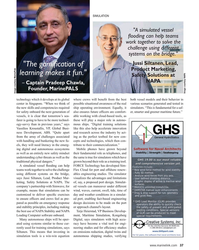 )
April 2024 - Maritime Reporter and Engineering News page: 37
)
April 2024 - Maritime Reporter and Engineering News page: 37and technologies, which then con- els, they will need literacy in the emerg- tribute to their commercialization.” ing digital and autonomous ecosystems Mobile phones have grown beyond as well as an entirely new safety mindset their fundamental role as telephones, and understanding cyber threats as well
-
 )
April 2024 - Maritime Reporter and Engineering News page: 27
)
April 2024 - Maritime Reporter and Engineering News page: 27that. We don’t Century Sailor Of? ce (N17) in my ? rst ? ag of? cer job, and have the reliefs. involved in building the “MyNavy HR” portal as a mobile, That’s my concern if we get into a large-scale, long-term op- adaptive platform for the management of our active-duty eration. We can be reasonably
-
 )
April 2024 - Maritime Reporter and Engineering News page: 21
)
April 2024 - Maritime Reporter and Engineering News page: 21and offshore that start he – like most other burgeoning leaders in the sector sectors – today it is not possible for ABS to put a de? nitive – became ‘mobile and global’, working with SBM in the ? oat- number on ‘how fast, how far’ this business will grow. “It is ing offshore world with FPSOs and the turret
-
 )
April 2024 - Maritime Reporter and Engineering News page: 15
)
April 2024 - Maritime Reporter and Engineering News page: 15meets its underwater noise limits. This will require specialized inception and cavitating area. The third approach should be test sites or specialized mobile underwater testing equipment. isolation mounting of a vibro-active equipment and machin- This process of designing and delivering a vessel meet- ery
-
 )
April 2024 - Maritime Reporter and Engineering News page: 13
)
April 2024 - Maritime Reporter and Engineering News page: 13from gasoline to methanol, but compared to just buying an EV After some pondering, I think I can reduce it to this logi- today that is a pointless exercise. It would actually make more cal sequence: sense to buy a plug-in hybrid that is con? gured for methanol It is the carbon. We want zero carbon as
-
 )
February 2024 - Marine News page: 36
)
February 2024 - Marine News page: 36of simulators, which the ferry operator has the DNV level, and we were the ? rst ones there with a DNV been deploying to various sites where they can do mobile certi? cate at the International Maritime Organization (IMO).” training. “They’ll have a crew coming off a ferry at a cer- Burry emphasized the signi
-
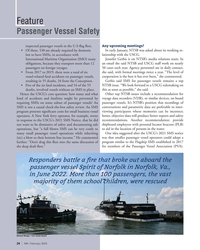 )
February 2024 - Marine News page: 24
)
February 2024 - Marine News page: 24Feature Passenger Vessel Safety Any upcoming meetings? inspected passenger vessels in the U.S-? ag ? eet. • Of these, 530 are already required by domestic In early January, NTSB was asked about its working re- law to have SMSs, in accordance with lationship with the USCG. International Maritime
-
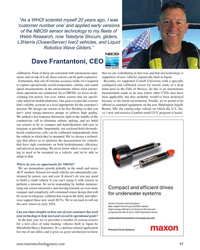 )
January 2024 - Marine Technology Reporter page: 49
)
January 2024 - Marine Technology Reporter page: 49CTDs may have veloping low-power, low-cost, robust sensors that are speci? - been applicable, but they probably would’ve been destroyed cally tuned for mobile platforms. Our goal is to provide a sensor because of the harsh environment. Finally, we’re proud to be that’s reliably accurate at a level appropriate
-
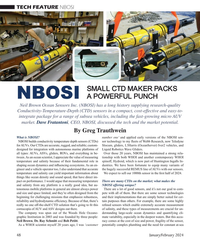 )
January 2024 - Marine Technology Reporter page: 48
)
January 2024 - Marine Technology Reporter page: 48There are many CTDs on the market; what makes the and salinity from any platform is a really good idea, but au- NBOSI offering unique? tonomous mobile platforms in general are almost always power There are a lot of good sensors, and it’s not our goal to com- and size and space limited, and they’re
-
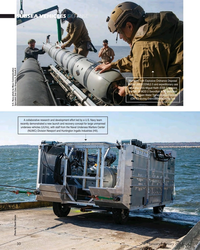 )
January 2024 - Marine Technology Reporter page: 30
)
January 2024 - Marine Technology Reporter page: 30SUBSEA VEHICLES DEFENSE Members from Explosive Ordnance Disposal Mobile Unit (EODMU) 5 and expeditionary sea base ship USS Miguel Keith (ESB 5) prepare the MK 18 MOD 2 Sword? sh to be deployed from the Open Water Transportation System (OWTS) during Exercise Noble Vanguard. U.S. Navy photo by Mass
-
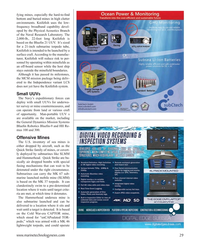 )
January 2024 - Marine Technology Reporter page: 29
)
January 2024 - Marine Technology Reporter page: 29bombs with special fusing mechanisms that can wait to be detonated under the right circumstance. Submarines can carry the MK 67 sub- marine launched mobile mine (SLMM) is based on the MK 37 torpedo. It can clandestinely swim to a pre-determined location where it waits until target crite- ria are met
-
 )
January 2024 - Marine Technology Reporter page: 18
)
January 2024 - Marine Technology Reporter page: 18TECH FEATURE WAVE POWER All images courtesy Mocean Energy MOCEAN ENERGY AIMS TO CREATE AN OFFSHORE RENEWABLE MICROGRID Garnering power from ocean waves is a generation behind the progress of offshore wind, but Mocean Energy, led by founder and managing director Cameron McNatt, is aiming to help offshore
-
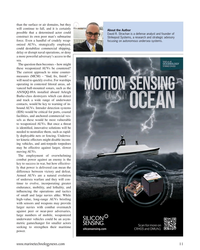 )
January 2024 - Marine Technology Reporter page: 11
)
January 2024 - Marine Technology Reporter page: 11AUVs bristling with sensors and weapons may provide larger navies with combat overmatch against peer or near-peer adversaries, large numbers of mobile, weaponized underwater vehicles could be an asym- metric gamechanger for smaller actors seeking to strengthen their maritime power. www.marinetechnologyn
-
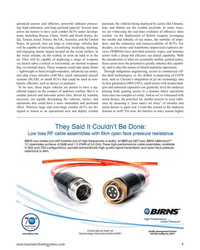 )
January 2024 - Marine Technology Reporter page: 9
)
January 2024 - Marine Technology Reporter page: 9with a cheap but effective sea denial capability. With air. They will be capable of deploying a range of weapons the introduction of what are essentially mobile, guided mines, via launch tubes (vertical or horizontal), an internal weapons these actors have the potential to greatly enhance this capabil- bay
-
 )
January 2024 - Marine Technology Reporter page: 8
)
January 2024 - Marine Technology Reporter page: 8INSIGHTS SUBSEA DEFENSE SILENT, MOBILE, DEADLY: THE RISE OF COMBAT AUVS Copyright Jesper/AdobeStock By David Strachan, Senior Analyst, Strikepod Systems rone warfare has come into its own. The war in targeted by warship point defense systems and helicopter gun- Ukraine, what many analysts are calling
-
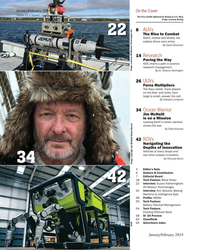 )
January 2024 - Marine Technology Reporter page: 2
)
January 2024 - Marine Technology Reporter page: 22024 On the Cover Volume 67 • Number 1 The Orca XLUUV delivered by Boeing to U.S. Navy Image courtesy Boeing 8 AUVs 22 The Rise to Combat Silent, mobile and deadly, the subsea drone wars arrive. By David Strachan 14 Research Paving the Way NOC charts a path in science research management. By
-
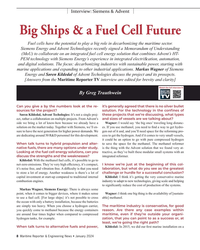 )
January 2024 - Maritime Reporter and Engineering News page: 8
)
January 2024 - Maritime Reporter and Engineering News page: 8Siemens Energy Big Ships & a Fuel Cell Future Fuel cells have the potential to play a big role in decarbonizing the maritime sector. Siemens Energy and Advent Technologies recently signed a Memorandum of Understanding (MoU) to collaborate on an integrated fuel cell energy solution that combines Advent’s
-
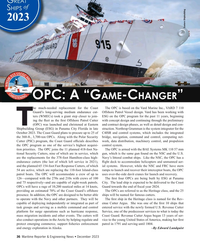 )
December 2023 - Maritime Reporter and Engineering News page: 36
)
December 2023 - Maritime Reporter and Engineering News page: 36Rev- capable of deploying independently or integrated as part of enue Cutter Argus. She was one of the ? rst 10 ships that task groups and serving as a mobile command and control entered service with the newly formed U.S. Revenue Cutter platform for surge operations such as hurricane response, Service
-
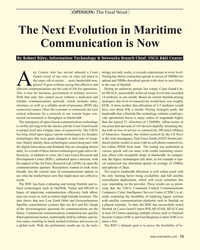 )
November 2023 - Maritime Reporter and Engineering News page: 73
)
November 2023 - Maritime Reporter and Engineering News page: 73OPINION: The Final Word The Next Evolution in Maritime Communication is Now By Robert Riley, Information Technology & Networks Branch Chief, USCG R&D Center ny Coastie who has served onboard a Coast nology not only works, it exceeds expectations at every level. Guard vessel of any size, or class can
-
 )
November 2023 - Maritime Reporter and Engineering News page: 70
)
November 2023 - Maritime Reporter and Engineering News page: 70In the Shipyard Latest Deliveries, Contracts and Designs Marcelle Melosira: Hybrid Research Vessel Derecktor Shipyards NY in Mamaroneck, N.Y. has deliv- tion with UVM and Chartwell, the 64-foot research catamaran ered a new hybrid research catamaran to the University of has been crafted to ful? ll the
-
 )
November 2023 - Maritime Reporter and Engineering News page: 31
)
November 2023 - Maritime Reporter and Engineering News page: 31Digital, StormGeo the ocean? 100%. Do we know exactly what that is looking [email protected] www.cimolaitechnology.com Ship Lifting Platforms “Cimolift” Mobile Boat Hoists Portal Cranes Transfer Systems www.marinelink.com 31 MR #11 (18-33).indd 31 11/2/2023 9:21:02 A
-
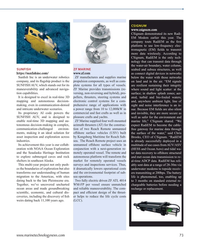 )
September 2023 - Marine Technology Reporter page: 73
)
September 2023 - Marine Technology Reporter page: 73CSIGNUM www.csignum.com CSignum demonstrated its new Radi- EM Modem earlier this year. The company touts RadiEM as the ? rst platform to use low-frequency elec- tromagnetic (EM) ? elds to transmit more data wirelessly. According to CSignum, RadiEM is the only tech- nology that can transmit data through
